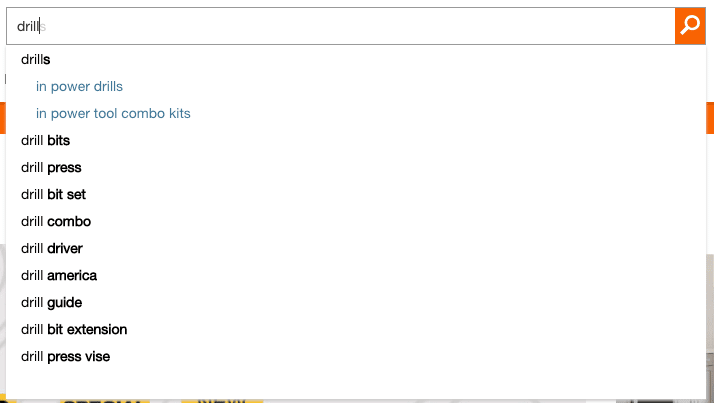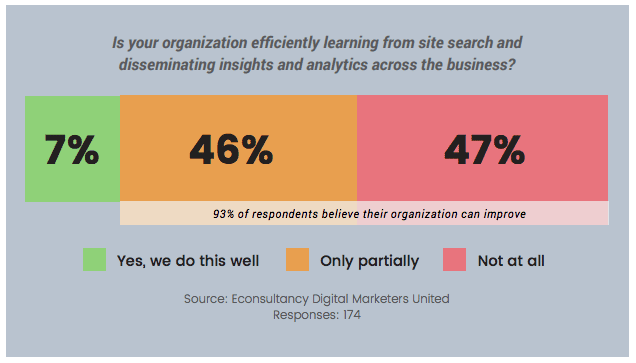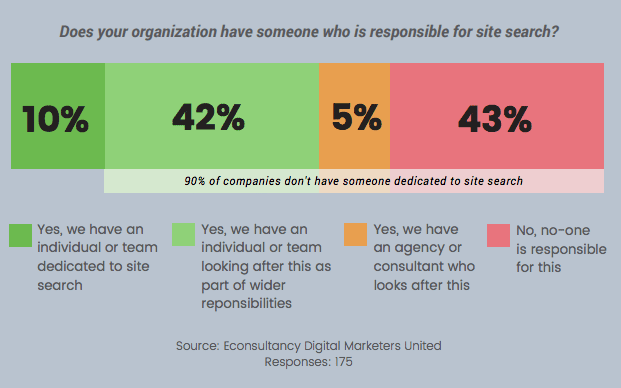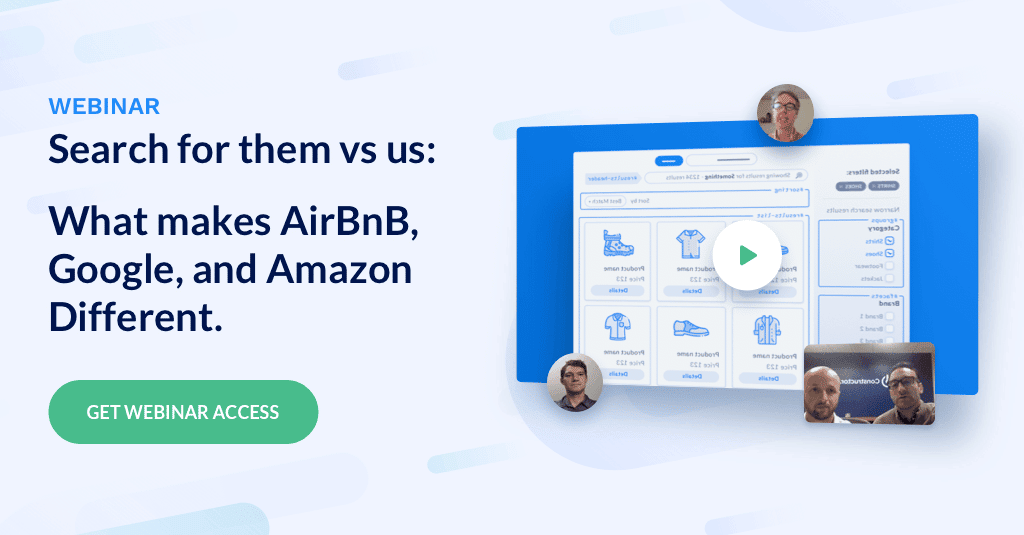Why intuitive site search is crucial to e-commerce
There’s a battle being waged for your users’ attention. Google and Amazon are investing millions of dollars into their search experiences to attract users to their sites. Other retailers are struggling to keep up with their e-commerce search systems.
In order to keep users on your site, it’s critical to challenge this shift. In other words, it’s vital that your site’s e-commerce search experience rivals or outshines Google’s and Amazon’s.
Why do the most successful enterprise e-commerce retailers invest so heavily in search? Because users who search are some of the most valuable customers for online retailers:
- On-site searchers are 216% more likely to convert than regular users (WebLinc)
- Up to 30% of e-commerce visitors will use internal site search, and this group converts 5-6X higher than the average non-site search visitor (Econsultancy).
Despite the fact that site search offers obvious benefits, many enterprises fail to offer robust search that delivers the right products to the right people at the right time.
Even among the top 50 grossing e-commerce sites in the U.S., 70% of e-commerce search engines are unable to return relevant results when synonyms are used, according to Baymard Institute. Additionally, 65% of the time, people have to use more than one search attempt – with three to four queries being common – to find the products they’re looking for. Yikes.
Why haven’t these other companies caught up to Amazon and Google? Search is hard. Search requires mastering user experience optimizations, retaining talented search engineers, deploying sophisticated infrastructure, and iterating constantly to keep improving.
This guide is your go-to resource for understanding e-commerce search best practices so that you can implement a robust system at your company and save on hidden costs. It offers insights to make search easy and intuitive to users, use data and analytics to understand and act on trends, optimize for speed and performance, and find the right site search solution to support your efforts.
Best Practice #1: Make search easy and intuitive for site visitors
The goal of e-commerce search is simple – allow users to find the products they’re looking for. The concept is easy. Execution is trickier.
Some enterprise retailers jump straight to the technical side of search – algorithms and big data – but user experience (UX) matters. A well-designed user interface can increase conversions on a website by 200%, according to a recent study from Forrester Research.
Google and Amazon have trained users to start their purchase experience with a search. Your users will behave the same on your site, even though you may have invested lots of time and energy into beautiful catalog pages. Your responsibility is to embrace your users’ natural behavior, and make it as easy and simple as possible to search your products
Check your search bar location
Make it accessible
Make sure your search bar is easy to find on your page. Make it big, make it bold, and put it at the center of the screen. Hiding your search bar behind the click of an icon or banishing it to the remote corners of your site frustrates your highest-converting customers: searchers! Instead, put your search bar prominently in the top middle or top right of your site, where users expect to find it.

Make it usable
When it comes to usability, conformity trumps creativity. Use a standard sans serif font in your search bar. Aim for readability over originality. Furthermore, make sure your search bar is big enough for most of your users’ queries. It feels clunky to type in a search and not be able to see the entire query. Look through your search logs and size your search bar so that 95% of your users’ queries fit into it.
Make it interactive
Users expect modern-day search bars to help guide them to their destination. Adding autosuggest (a list of suggested products and searches) allows the user to explore your catalog quickly and easily. Further, it increases your users’ engagement with your site, and invests them in finding what they want. (Constructor.io offers autosuggest as a service with only two lines of code.)
Encourage users to narrow searches
Users often make very broad searches that are difficult to match to the best product. For example, they might search “banana,” not specifying whether they want a standard banana from the fruits & vegetables department, or whether they want banana-flavored baby food, which falls under the category of babies & kids.
If you don’t account for these types of broad searches, you likely won’t deliver the right results. To address this, you can offer suggestions to guide visitors to better qualify their search. For example:

Many sites provide such categories at the left of the search results page. This is helpful, but our data show users often fail to engage with these long lists of category suggestions, growing frustrated with overbroad or irrelevant results. The best approach is to offer suggested category facets at the time a user is initiating their search – in the autosuggest recommendations displayed as users type.
Finally, make sure you curate the category suggestions to show only the most relevant ones: the categories with the highest-selling products matching a user’s intent. A data science team is best suited to perform this work by analyzing your search logs to extract the most popular categories for each common search term.
Use autosuggest
Autosuggest is an essential feature of any intuitive e-commerce search interface. As a user is typing, autosuggest helps them complete their answer so that they can further narrow their search. For example, if you search for “drill” on Home Depot’s website, you’ll automatically be given a suggested search list.

Autosuggest is sometimes also known as autocomplete, predictive search, or type-ahead.
You can also use autosuggest to display product results in real-time as users type. Real-time search provides live feedback about the products available for the searches a user may perform.
If users can see search results in real-time, they’ll know whether they’re on the right track. Real-time results can also help users catch their own misspellings and encourage them to adjust their parameters as they go.
Employ the right filters
E-commerce sites often stumble when it comes to using relevant search filters. Many use identical filters across their site, even though they sell significantly different products across their categories. The challenge here is to figure out which filters make sense for a given search. For example, the filters for products in the women’s clothing category should be different than they are for those in the electronics category.
Zappos provides different filters if you’re searching for high-heeled shoes than it does if you’re searching for dresses. For shoes, Zappos displays the heel height and style, while for dresses they display the dress material and theme.

Determining relevant search filters for each product can be daunting if the information isn’t part of your product catalog. A skilled data science team can use natural language processing (NLP) and entity recognition to help determine the best filters for your catalog.
Best Practice #2: Use data and analytics to understand e-commerce search trends – and act on them
In order to provide robust e-commerce search, you must use data and analytics to understand trends – and then act on them. If you’re able to understand which search queries yield zero results, and which ones result in the most conversions, you’ll have mastered the first steps to improving your search experience.
Unfortunately, most retailers and e-commerce sites aren’t using data to their advantage. A survey by Econsultancy found that 93% of respondents believed their organization was NOT doing well at learning from site search and disseminating insights and analytics across the business.

When companies are able to leverage site search analytics, the ROI is obvious. A case study by IBM showed that FootSmart.com, a shoe retailer, was able to improve its site search conversion rate by 82% by enacting a weekly monitoring campaign of underperforming search terms, and adjusting the results accordingly.
Analytics to monitor
If you want to improve your e-commerce search, you need to do a deep dive into your analytics to see what’s working well – and what’s not working so well. These analytics give team members the knowledge to make meaningful changes. Organizations with high-performing site search monitor the following analytics:
| Zero-Result Searches | Conversion Rates |
|---|---|
| Monitoring searches that don’t return any results is an important part of improving any search experience. These zero-result searches give you valuable data about what your customers are looking for but aren’t finding, giving you important clues about what products or services you should add, or which search engine changes to implement. | Whether you define a “conversion” as a sale, a sign-up, or some other action, it’s important to monitor how likely your users are to convert after a search. It’s crucial to understand which search terms have the highest and lowest conversion rates, so you can improve your search results, enhance metadata, or adjust the products you sell. |
| Abandoned Searches | Success Rate |
| An abandoned search is when a visitor makes a search and then leaves your site. Identifying these searches and improving their results is key to improving your search experience. | Success rate measures how often visitors perform a search and then buy something. This is an important metric to track over time to make sure you’re improving it. |
| Revenue Per Search | Time to Conversion |
| You may also want to explore revenue per search, which quantifies how much revenue, on average, you get from each search performed on your site. This number should trend upwards as you improve your search experience. | This metric tracks how long it takes someone to get from their first search to a product page or conversion. Does it take 30 seconds or 5 minutes? If it’s fast, it means people are finding what they need using your search engine. |
| Search Usage | Search Refinements |
| You should understand how many of your users actually use the search engine, and how many of those convert. What percentage of your site visitors actually use search? | How often do users have to refine their searches before they get relevant results? There may be certain queries that users often refine, which may be indicative of problem areas in your search. |
Acting on Information
Once you understand the e-commerce search analytics, you have to act on them. In order to be effective, you have to take your unique site into consideration, come up with an implementation roadmap, convince key stakeholders that search matters, and disseminate a gameplan across teams.
Remember, your e-commerce site is unique
The willingness of users to page through search results varies from site to site, and can have a big impact on the effectiveness of your search engine.
For example, on some sites, users only glance at the first few search results before deciding that the site doesn’t have what they’re looking for. In those cases, it’s vital that you work to encourage users to narrow their search and ensure that those results that are returned are highly relevant.
On other sites, users are quite willing to page through many results. If that’s the case for your users, you can take advantage of this by adding more keywords to your product listings, so that more results get returned. In order to figure this out, conduct some user testing. Sit down with 10 actual users and watch their behavior.
Come up with an implementation roadmap
Data can tell you a lot about how your users are behaving. These analytics will help you understand how much value search provides to your organization and give you ideas for how you can improve.
Based on your analytics, you need to formalize a plan for making changes to your e-commerce search. This plan might include changing the way filters and facets operate, implementing autosuggest, or finding a new site search solution altogether.
Get buy-in from key stakeholders and disseminate a gameplan across teams
One of the keys to improving e-commerce search is to get buy-in from key stakeholders. According to Econsultancy, only 10% of companies have an individual or team dedicated to site search. This suggests that key stakeholders may not be prioritizing site search within their organizations.

It’s up to you to get buy-in from key stakeholders at your company, and make sure that the importance of improving site search is communicated across teams.
Best Practice #3: Optimize for relevance and performance
E-commerce search engines should be optimized for the users they serve, but this goes beyond an eye-pleasing design and the right filters. Speed and performance matter – a lot. Back in 2006, Amazon lost 1% of sales, or $1.6B, for every 100ms of latency. And that was back when users expected slow sites!
Retailers with the best search experiences constantly iterate to make their engines perform faster and deliver more relevant results to users.
Faster is better
It’s no secret that speed matters, and when it comes to anything on the web, faster is better. After all, it’s been found that a one second delay can result in 7% fewer conversions and 11% fewer page views.
If people search and then have to wait for results to populate, they’re much more likely to abandon their search. Additionally, slow site and search speeds negatively impact your site’s ability to rank in Google search results.
Performance is important to users
When you’re working to improve your e-commerce search engine, you need to prioritize the optimization of performance. That’s because performance matters a whole lot to your users. In fact, nearly 80% of customers who notice performance issues will be less likely to buy from you in the future, according to Quantum Dynamix.
Improve relevance with precision and recall
It’s important to quantitatively measure e-commerce search relevance to ensure that any changes you make improve the search results over time. One popular method of measuring relevance is using precision and recall.
| Precision | Recall |
|---|---|
| Precision captures how many search results are relevant to the search term. For instance, if you search for “jacket,” how many search results shown are for jackets? You can get a good measure of precision by simply taking your top 10 most popular search queries and calculating the percent of items on the first page of results that match the query. |
Just as important as precision is recall, or how many items that should have been returned actually were. If you search for “jacket” and get one result, but your site actually sells 100 different kinds of jackets, that’s very low recall. You can measure recall by taking those same top 10 most popular search queries and calculating the percent of items returned relative to all of the results that should have been returned. |
| Good Precision, Bad Recall | Bad Precision, Good Recall |
| Imagine you have 10 jackets in your catalog of 1,000 products. When users search for ‘jacket,’ they see just 5 results, all of which are jackets. Since 100% (5/5) of products displayed are jackets, your precision is perfect. However, only 50% of the jackets in your catalog were displayed, so your recall needs some work! | In contrast, imagine you have the same catalog. Now when users search ‘jacket,’ they instead see 20 products, of which 10 are jackets. Since only 50% (10/20) of products displayed are relevant to the search, your precision is poor. But since you returned 100% of jackets in your catalog, your recall is perfect. |
To improve precision, you can narrow the fields that your e-commerce search engine indexes. For instance, descriptions of products often contain many words that aren’t relevant to the product itself. (Imagine a rain jacket whose description is, “This lightweight, waterproof jacket is the perfect companion for your trip to a tropical rainforest!”) By tuning your e-commerce search engine to ignore irrelevant words and fields, you can improve the precision of your results.
To improve recall, you can add more keywords to specific products or groups of products, or add synonym lists so that related words return relevant results. For instance, you could add “coat” as a synonym for “jacket.”
You’ll find that precision and recall balance each other, which is why it’s important to measure both. Often, tuning your search engine to improve precision will hurt recall, and vice versa. The best balance depends on your product catalog, your customers’ queries, and your search engine. You’ll find the balance that’s best for your site as you measure the results over time.
Improve relevance with automatic synonym detection and entity recognition
Manually tuning e-commerce search engines to improve relevance is a thankless and never-ending task. Modern search services use automatic synonym detection to quickly learn relationships between words. For instance, a self-learning system could notice that people who type “sneakers” get zero results, after which they often search for “shoes.” It would realize there’s a relationship between these two terms and automatically recognize them as synonyms.
Similarly, a search for “Paris Hilton” can be devilishly hard for a basic search engine. Is “Paris” a city? Is “Hilton” a hotel chain? Most search engines don’t have the ability to classify either word, let alone understand that the two words together mean something completely different than each word alone. An intelligent search engine with entity recognition can understand the context behind a user’s search and guide them to relevant search results.
Best Practice #4: Use the right system for e-commerce search
We’ve tried to steer you in the right direction to improve your e-commerce search experience, but the reality is that most of these improvements require significant investments in data science and machine learning. Ultimately, the best answer is to use a system with these data insights and machine intelligence built-in.
There is a tidal wave of change coming – from self-driving cars to cancer recognition – driven by machine intelligence. Automated learnings from large datasets are crucial to competing with the internet giants. Deploying a self-learning, automated site search service like the one provided by Constructor.io puts you far ahead of a custom-built solution that is difficult to maintain and improve. When you implement a battle-tested search platform, you see immediate benefits and save on engineering costs.
Advanced search systems track user behavior across a global logging platform and use that data to feed their ranking algorithms to constantly improve the search experience for users. Behind the scenes, teams of algorithm experts and data scientists tune the algorithms to continually bring the benefits of the data to as many users as possible. Most companies don’t
have the resources to support the infrastructure and engineering teams necessary to tackle these challenges.
Offer e-commerce search that delights
By understanding the best practices we’ve outlined in this guide, you should have everything you need to develop a solid site search solution for your e-commerce or retail business – one that’s customized to suit your particular business and its customers.
Want to learn how brands like Amazon and Google win at site search?
Consumers now expect Google-level search experiences from every site they visit — and e-commerce giants are investing heavily in their search bar to keep up.
So, how can you match their pace? Or better yet…
How can you *outpace* them?
In our new webinar, we’ll show you exactly what tools and tactics brands like Amazon, AirBnB, and Google use to dominate the search market (and how you can stop losing valuable customers by optimizing your search bar). Get access today!


